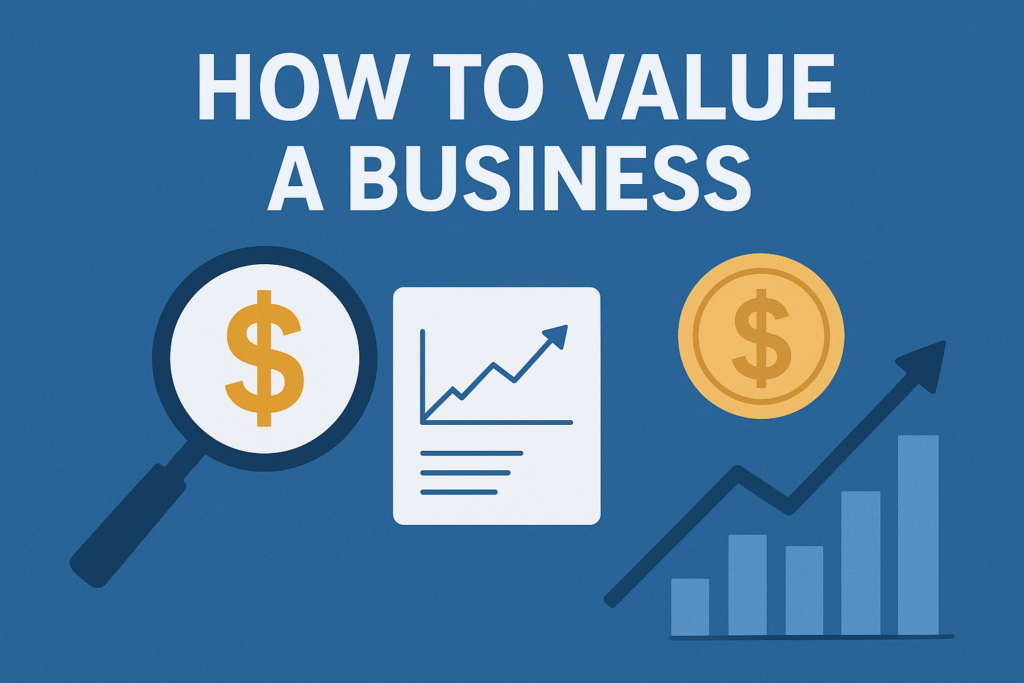Understanding the value of a business is one of the most important aspects of financial decision-making. Whether you are planning to sell your company, attract investors, merge with another organization, or simply assess financial health, business valuation provides a clear measure of worth. Unlike simple accounting figures, valuation captures not just assets and sales, but also future growth potential, brand reputation, customer loyalty, and overall market position.
This guide covers how business valuation works, the most common methods used, step-by-step calculation approaches, strategies to increase valuation, and real-world scenarios. By the end, you’ll have a clear framework for evaluating a company’s financial standing with accuracy and confidence.
What Is a Business Valuation?
A business valuation is the process of determining the economic value of a company. It goes beyond profit and revenue — taking into account a business’s overall financial health, future prospects, and market position.
A business valuation typically includes an in-depth analysis of the company’s:
- Management – evaluating leadership quality, operational efficiency, and strategic direction.
- Capital Structure – assessing the balance of debt and equity financing.
- Future Earnings Prospects – projecting profitability, growth, and cash flow sustainability.
- Market Value – comparing performance with competitors and industry averages.
- Assets and Liabilities – reviewing tangible and intangible assets, debts, and obligations.
This comprehensive evaluation provides stakeholders with a clearer picture of both current worth and future potential, ensuring informed decisions during mergers, acquisitions, or strategic planning.
How Business Valuation Works
Business valuation typically involves a multi-step analysis:
- Reviewing Financial Statements – Balance sheets, income statements, and cash flow statements are examined.
- Normalizing Earnings – Removing unusual or one-time costs (e.g., lawsuit settlements, temporary COVID-19 impacts).
- Comparing with Industry Benchmarks – Looking at multiples or margins common in the sector.
- Applying Valuation Methods – Different approaches (earnings-based, asset-based, or market-based) are chosen depending on business type.
- Arriving at Value Range – Instead of a fixed number, valuations often provide a high-low range to allow for negotiation.
A professional appraiser, CPA, or investment banker may be hired for accuracy, especially for high-value or complex businesses.
6 Most Common Business Valuation Methods
1. Market Capitalization
Market capitalization (market cap) is the simplest and most widely recognized valuation method for publicly traded companies.
Formula:
Market Cap = Share Price × Total Outstanding Shares
- Example: If Company A trades at $50 per share with 10 million shares outstanding, its market cap = $500 million.
Pros:
- Simple and easy to calculate.
- Reflects real-time investor sentiment and market demand.
- Transparent for publicly listed firms.
Cons:
- Not useful for private companies without traded shares.
- Subject to stock market volatility—prices can rise or fall dramatically based on investor sentiment rather than fundamentals.
Best For: Large, publicly traded companies where share prices are readily available.
2. Times Revenue Method
The times revenue method values a business based on its annual revenue multiplied by an industry-specific factor (multiplier).
Formula:
Business Value = Revenue × Revenue Multiple
- Example: A SaaS business with $5 million annual revenue and a revenue multiple of 3 = $15 million valuation.
Pros:
- Quick and widely used in industries with consistent revenue multiples (e.g., tech, e-commerce).
- Useful for startups that may not yet be profitable but show strong revenue growth.
Cons:
- Ignores expenses and profitability—two businesses with the same revenue but different profit margins would have different real values.
- Multipliers vary widely across industries (a retail store may have a multiple of 0.5–1, while a software firm could be 3–10).
Best For: Growth-focused businesses and startups where sales growth is a major indicator of value.
3. Earnings Multiplier
The earnings multiplier (commonly linked with the Price-to-Earnings or P/E ratio) is based on profits rather than revenue.
Formula:
Business Value = Net Earnings × P/E Multiple
- Example: A company earning $1 million annually with a P/E multiple of 12 is valued at $12 million.
Pros:
- Adjusts for profitability, offering a clearer financial picture than revenue-only methods.
- Reflects risk and return, since multiples are tied to market expectations.
Cons:
- Requires reliable profit figures, which some businesses lack (especially startups).
- Multiples differ by industry and market cycle—tech companies may trade at high multiples while manufacturing firms have lower ones.
Best For: Businesses with steady and predictable earnings.
4. Discounted Cash Flow (DCF) Method
The DCF method is one of the most detailed and forward-looking valuation techniques. It estimates the value of a business based on future cash flows discounted to present value.
Formula (simplified):
DCF Value = Σ (Cash Flow ÷ (1 + Discount Rate)^Year)
- Example: If a business expects $2 million in free cash flow annually for 5 years and a 10% discount rate is applied, each year’s cash flow is discounted back and summed to calculate present value.
Pros:
- Highly accurate when projections are reliable.
- Considers time value of money—future earnings are worth less today.
- Suitable for businesses with predictable cash flows.
Cons:
- Complex—requires accurate forecasting, which may be difficult in volatile industries.
- Highly sensitive to small changes in assumptions (e.g., discount rate).
Best For: Established businesses with stable financial performance and clear growth projections.
5. Book Value
Book value represents the net asset value of a company as shown on its balance sheet.
Formula:
Book Value = Total Assets – Total Liabilities
- Example: A company with $10 million in assets and $4 million in liabilities has a book value of $6 million.
Pros:
- Simple and grounded in accounting records.
- Provides a “floor value” for businesses.
Cons:
- Ignores intangible assets like brand, customer loyalty, or patents.
- May undervalue companies with strong earnings potential.
Best For: Asset-heavy businesses like real estate firms, manufacturing companies, or banks.
6. Liquidation Value
Liquidation value calculates how much would be left if a company sold all assets quickly and paid off debts.
- Example: A business with $8 million in assets and $6 million in liabilities may only realize $2 million or less if assets are sold under pressure.
Pros:
- Represents a conservative estimate and “worst-case scenario.”
- Useful for distressed businesses or bankruptcy cases.
Cons:
- Usually the lowest valuation since assets are often sold below market value.
- Doesn’t reflect ongoing business potential.
Best For: Companies in distress, liquidation, or restructuring.
How Do I Calculate the Value of My Business?
To calculate business value:
- Collect financial data (income, assets, liabilities, cash flow).
- Normalize earnings by adjusting unusual or non-recurring items.
- Select valuation method(s) suitable for your business model.
- Apply industry multiples for comparison.
- Work with professionals like certified appraisers for accuracy.
A blended approach often gives the most balanced valuation.
How to Increase Your Business Valuation
- Boost profitability by improving efficiency.
- Diversify revenue streams to reduce dependency.
- Build a loyal customer base with recurring contracts.
- Invest in intangible assets such as patents, trademarks, and brand equity.
- Maintain transparent financial reporting to attract investors.
- Demonstrate growth potential through strategic planning.
How Much Is a Business Worth With $500,000 in Sales?
Valuation for a $500,000-sales business varies by method:
- Times Revenue Method: If multiplier = 2, value ≈ $1 million.
- Earnings Multiplier: If 20% profit margin ($100,000 profit) and P/E multiple = 8, value ≈ $800,000.
- Book Value: Could differ depending on assets and liabilities.
Realistically, such a business may be worth $500,000 to $1.5 million, depending on profitability, sector, and growth potential.
What Are the Top 3 Business Valuation Methods?
While many exist, the most widely used and accepted are:
- Discounted Cash Flow (DCF) Method – Best for businesses with strong cash flow predictability.
- Earnings Multiplier (P/E Ratio) – Common for established, profitable businesses.
- Times Revenue Method – Frequently used for startups and service-based businesses.
Together, these provide a well-rounded valuation covering current performance, future potential, and industry benchmarks.
Final Thoughts
Business valuation is not just about numbers—it’s about understanding the true economic worth of a company. Each method has its advantages and limitations, and the right approach often depends on the business type, industry, and purpose of valuation.
For small businesses, revenue multiples and book value may be more practical, while for large or growth-oriented companies, DCF and earnings-based methods provide a more realistic measure. Regardless of the method chosen, working with professionals such as CPAs, financial analysts, or certified appraisers ensures credibility and accuracy.
Whether you are preparing to sell, attract investors, or simply plan for the future, a solid grasp of business valuation empowers you to make strategic financial decisions with confidence.







